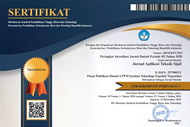Efek Gradasi Tanah Pasir Pada Penggunaan Jamur Rhizopus Oligosporus untuk Perbaikan Tanah Pasir Lepas
Abstract
Keywords
Full Text:
PDFReferences
T. Rivas, Erosion Control Treatment Selection Guide. 2006.
R. W. Boulanger, M. Khosravi, A. Khosravi, and D. W. Wilson, “Remediation of liquefaction effects for an embankment using soil-cement walls: Centrifuge and numerical modeling,” Soil Dyn. Earthq. Eng., vol. 114, no. December 2017, pp. 38–50, 2018, doi: 10.1016/j.soildyn.2018.07.001.
J. Fan, D. Wang, and D. Qian, “Soil-cement mixture properties and design considerations for reinforced excavation,” J. Rock Mech. Geotech. Eng., vol. 10, no. 4, pp. 791–797, 2018, doi: 10.1016/j.jrmge.2018.03.004.
J. T. DeJong, M. B. Fritzges, and K. Nüsslein, “Microbially Induced Cementation to Control Sand Response to Undrained Shear,” J. Geotech. Geoenvironmental Eng., vol. 132, no. 11, pp. 1381–1392, 2006, doi: 10.1061/(asce)1090-0241(2006)132:11(1381).
J. T. DeJong, B. M. Mortensen, B. C. Martinez, and D. C. Nelson, “Bio-mediated soil improvement,” Ecol. Eng., vol. 36, no. 2, pp. 197–210, 2010, doi: 10.1016/j.ecoleng.2008.12.029.
I. Chang, A. K. Prasidhi, J. Im, and G. C. Cho, “Soil strengthening using thermo-gelation biopolymers,” Constr. Build. Mater., vol. 77, pp. 430–438, 2015, doi: 10.1016/j.conbuildmat.2014.12.116.
I. Chang and G. C. Cho, “Strengthening of Korean residual soil with β-1,3/1,6-glucan biopolymer,” Constr. Build. Mater., vol. 30, pp. 30–35, 2012, doi: 10.1016/j.conbuildmat.2011.11.030.
A. Lim, P. C. Atmaja, and S. Rustiani, “Bio-mediated soil improvement of loose sand with fungus,” J. Rock Mech. Geotech. Eng., vol. 12, no. 1, 2020, doi: 10.1016/j.jrmge.2019.09.004.
J. Mitchell and K. Soga, Fundamental of Soil Behavior, 3rd ed. New York: John Wiley & Sons, 2005.
ASTM D2850-15, “Standard Test Method for Unconsolidated-Undrained Triaxial Compression Test on Cohesive Soils,” in ASTM International, West Conshohocken, PA: www.astm.org, 2015.
DOI: http://dx.doi.org/10.12962%2Fj2579-891X.v20i2.9769
Refbacks
- There are currently no refbacks.

Jurnal Aplikasi Teknik Sipil by Pusat Publikasi Ilmiah LPPM Institut Teknologi Sepuluh Nopember is licensed under a Creative Commons Attribution-ShareAlike 4.0 International License
Based on work at https://iptek.its.ac.id/index.php/jats




